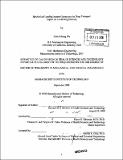| dc.contributor.advisor | Elazer R. Edelman. | en_US |
| dc.contributor.author | Wu, Peter I-Kung | en_US |
| dc.contributor.other | Harvard University--MIT Division of Health Sciences and Technology. | en_US |
| dc.date.accessioned | 2009-06-30T16:37:24Z | |
| dc.date.available | 2009-06-30T16:37:24Z | |
| dc.date.copyright | 2008 | en_US |
| dc.date.issued | 2008 | en_US |
| dc.identifier.uri | http://hdl.handle.net/1721.1/45914 | |
| dc.description | Thesis (Ph. D.)--Harvard-MIT Division of Health Sciences and Technology, 2008. | en_US |
| dc.description | Includes bibliographical references (leaves 152-166). | en_US |
| dc.description.abstract | Controlled-release drug-delivery systems enable efficient and defined administration of therapeutic agents to target tissues. However, ultimate drug distribution and pharmacologic effect are determined by target tissue pharmacokinetics. In muscular tissues, complex architecture that is further augmented by dynamic motion and contraction can alter the pharmacokinetics and deposition of locally delivered macromolecules. We developed a system and applied a quantitative schema to investigate the impact of controlled mechanical loads applied to skeletal and cardiac muscle tissue on intramuscular transport of locally delivered drug. In a series of studies, we examined how the interaction between architectural configuration and functional mechanics alters the transport of drugs across both physicochemical and binding properties. We correlated these pharmacokinetic effects with characteristic parameters in the physiologic range of the tissue to derive mechanistic insight into the fundamental structural and dynamic elements that underlie these effects. While previous studies have revealed the unilateral scaling of substrate uptake with mechanical influences, we elucidated an architecturally defined pharmacokinetic setpoint whereby maximal drug penetration corresponds with optimal muscle function. Our findings elucidate basic biologic design in muscle that optimizes the interface between tissue and its physical environment. The unique insights from our investigations have broad impact on current understanding of the pharmacokinetic influences of biologic form and function, and elucidate new clinical strategies for controlled release and local delivery of a wide range of therapeutic compounds to mechanically active tissues. | en_US |
| dc.description.statementofresponsibility | by Peter I-Kung Wu. | en_US |
| dc.format.extent | 214 leaves | en_US |
| dc.language.iso | eng | en_US |
| dc.publisher | Massachusetts Institute of Technology | en_US |
| dc.rights | M.I.T. theses are protected by
copyright. They may be viewed from this source for any purpose, but
reproduction or distribution in any format is prohibited without written
permission. See provided URL for inquiries about permission. | en_US |
| dc.rights.uri | http://dspace.mit.edu/handle/1721.1/7582 | en_US |
| dc.subject | Harvard University--MIT Division of Health Sciences and Technology. | en_US |
| dc.title | Mechanical loading impacts intramuscular drug transport : impact on local drug delivery | en_US |
| dc.type | Thesis | en_US |
| dc.description.degree | Ph.D. | en_US |
| dc.contributor.department | Harvard University--MIT Division of Health Sciences and Technology | |
| dc.identifier.oclc | 320771344 | en_US |
